Atlantic Thread Herring, Opisthonema oglinum
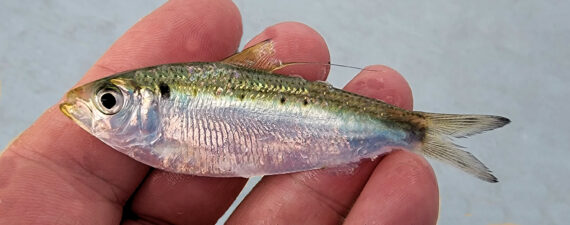 Atlantic Thread Herring, Opisthonema oglinum. Fish caught off the St. Augustine Fishing Pier, St. Augustine, Florida, June 2023. Length: 12 cm (4.7 inches). Catch, photograph and identification courtesy of Chris Moore, Peoria, Arizona.
Atlantic Thread Herring, Opisthonema oglinum. Fish caught off the St. Augustine Fishing Pier, St. Augustine, Florida, June 2023. Length: 12 cm (4.7 inches). Catch, photograph and identification courtesy of Chris Moore, Peoria, Arizona.
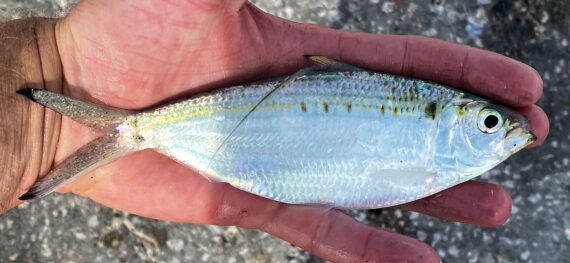 Atlantic Thread Herring, Opisthonema oglinum. Fish caught from coastal waters off Ft. Lauderdale, Florida, July 2020. Length: 17.5 cm (5.9 inches). Catch, photograph and identification courtesy of Luke Ovgard, Klamath Falls, Oregon.
Atlantic Thread Herring, Opisthonema oglinum. Fish caught from coastal waters off Ft. Lauderdale, Florida, July 2020. Length: 17.5 cm (5.9 inches). Catch, photograph and identification courtesy of Luke Ovgard, Klamath Falls, Oregon.
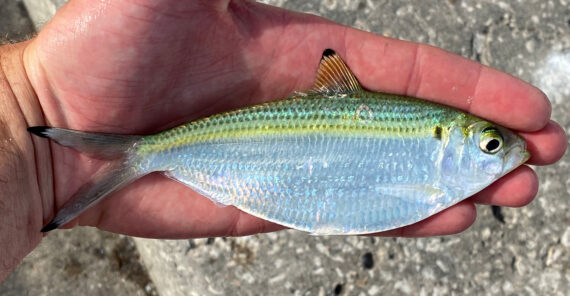 Atlantic Thread Herring, Opisthonema oglinum. Fish caught from coastal waters off Ft. Lauderdale, Florida, July 2020. Length: 17.5 cm (5.9 inches). Catch, photograph and identification courtesy of Luke Ovgard, Klamath Falls, Oregon.
Atlantic Thread Herring, Opisthonema oglinum. Fish caught from coastal waters off Ft. Lauderdale, Florida, July 2020. Length: 17.5 cm (5.9 inches). Catch, photograph and identification courtesy of Luke Ovgard, Klamath Falls, Oregon.
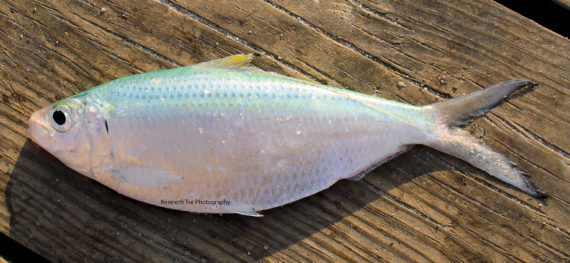 Atlantic Thread Herring, Opisthonema oglinum. Fish caught off the Sanibel Island Pier, Sanibel Island, Florida, April 2011. Length: 20.0 cm (7.9 inches). Catch, photograph, and identification courtesy of Kenneth Tse, Toronto, Canada.
Atlantic Thread Herring, Opisthonema oglinum. Fish caught off the Sanibel Island Pier, Sanibel Island, Florida, April 2011. Length: 20.0 cm (7.9 inches). Catch, photograph, and identification courtesy of Kenneth Tse, Toronto, Canada.
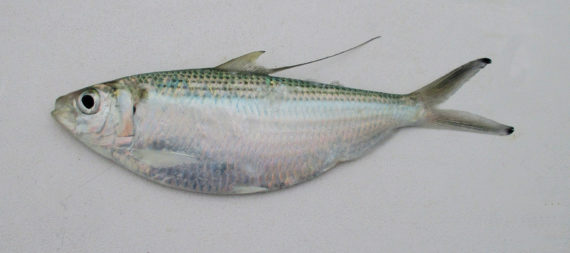 Atlantic Thread Herring, Opisthonema oglinum. Fish caught from coastal waters off Placida, Florida, March 2017. Length: 20.0 cm (7.9 inches). Catch, photograph, and identification courtesy of George Brinkman, Guelph, Ontario, Canada.
Atlantic Thread Herring, Opisthonema oglinum. Fish caught from coastal waters off Placida, Florida, March 2017. Length: 20.0 cm (7.9 inches). Catch, photograph, and identification courtesy of George Brinkman, Guelph, Ontario, Canada.
The Atlantic Thread Herring, Opisthonema oglinum, is a member of the Herring or Clupeidae Family, that are known in Mexico as sardina vivita de hebra. Globally, there are five species in the genus Opisthonema, of which four are found in Mexican waters, one in the Atlantic and three in the Pacific Ocean.
The Atlantic Thread Herring has a moderately deep, fusiform, and compressed body with a depth that is 34% to 38% of standard length. They are blue-green dorsally transitioning to silvery white on their sides and belly. They have a dark spot just behind the top corner of their gill cover. Some fish have dark longitudinal lines on their body. Their caudal fin has black tips and their dorsal fin margin and filament are dusky. Their head has a short oblique mouth that opens at the front and is equipped with small conical teeth. Their anal fin has 22 to 24 rays and is short and located well behind the dorsal fin; their caudal fin is forked; their dorsal fin has 18 or 19 rays and is located before the center of the body and its last fin ray is long and filamentous and extends to the caudal fin base; and, their pelvic fins are on the abdomen and inserted under the center of the dorsal fin base. They have 26 to 46 fine gill rakers and their belly has a distinct keel. They are covered with small irregular scales.
The Atlantic Thread Herring is a small coastal pelagic species and are widely distributed, common, and locally abundant in large schools found on the surface. They can also be found at depths up to 183 m (600 feet) but are normally seen in waters less than 3 m (10 feet). They reach a maximum 48 cm (19 inches) in length. They consume zooplankton including copepods, crabs, small fish, and shrimps. They are an important forage fish for large predatory fish. They are exceptionally fast and agile and make inshore migrations for reproduction. Reproduction is oviparous with external fertilization with each female releasing between 13,000 and 67,000 eggs annually. They are known to enter estuaries and rivers for use as nursery grounds. They have lifespans of up to eight years.
In Mexican waters the Atlantic Thread Herring is a resident of all Mexican waters of the Atlantic Ocean including the Gulf of Mexico and the east coast of the Yucatán Peninsula in the Caribbean.
The Atlantic Thread Herring is most likely confused with the Threadfin Shad, Dorosoma petenense (prominent black shoulder spot).
From a conservation perspective the Atlantic Thread Herring is currently considered to be of Least Concern with stable, widely distributed populations. They are caught globally at a level of 25,000 tons per year. In Mexican waters they are caught primarily by beach seines and gillnets in small coastal fisheries by artisanal fishermen at annual levels of 5,000 tons but these numbers have recently declined significantly due to overfishing. They are also caught by hook and line and by cast nets and as a by-catch of menhaden and shrimp fisheries by trawlers. They are used extensively by recreational anglers as bait fish. With the exception of United States waters, they are currently unregulated. Commercially they are used primarily to make fish meal and fish oil. On a limited basis they are canned and processed for pet food and human consumption.